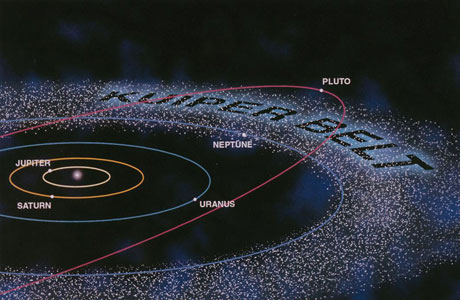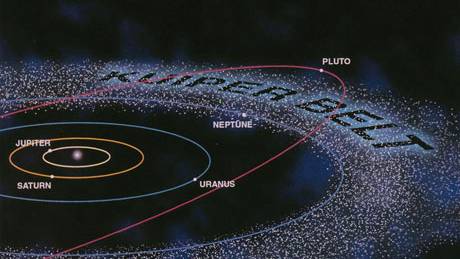Massive Impact in the Kuiper Belt 4.5 Billion Years Ago
Source: redorbit.com

In the outer reaches of the solar system, there is an object known as 2003 EL61 that looks like and spins like a football being drop-kicked over the proverbial goalpost of life.
Still awaiting a more poetic name, 2003 EL61 largely escaped the media hubbub during last year's demotion of Pluto, but new findings could make it one of the most important of the Kuiper-belt objects for understanding the workings of the solar system. In this week's Nature, the original discoverer of the body, Mike Brown, announces with his colleagues that an entire family of bodies seems to have originated from a catastrophic collision involving 2003 EL61 about the time Earth was forming.
Brown and his team base their assumptions on similar surface properties and orbital dynamics of smaller chunks still in the general vicinity. They conclude that 2003 EL61 was spherical and nearly the size of Pluto until it was rammed by a slightly smaller body about 4.5 billion years ago, leaving behind the football-shaped body we see today and a couple of moons, as well as many more fragments that flew away entirely.
"Some of these chunks are still in orbit around the sun and very near the orbit of 2003 EL61 itself," says Brown, a professor of planetary astronomy at the California Institute of Technology. "The impact made a tremendous fireball, and large icy chunks of the big object split off and went flying into space, leaving behind a huge ice-covered rock spinning end over end every four hours.
"It spins so fast that it has pulled itself into the shape of an American football, but one that's a bit deflated and stepped on," Brown adds.
A significant part of the finding is that the collision occurred in a region of space where orbits are not very stable. "In most places, things go around the sun minding their own business for 4.5 billion years and nothing happens," says Brown. "But in a few places, though, orbits go crazy and change and eventually objects can find themselves on a trajectory into the inner solar system, where they would be what we would then call comets."
As a consequence, many of the shards probably made their way to the inner solar system, and a few have undoubtedly hit Earth in the past. The study thus provides new ideas about how the solar system evolves, and how comets fit into the big picture.
Brown adds that 2003 EL61 will put on quite a show in about a billion years, if anyone is still around to enjoy it.
"It's a long time to wait, but 2003 EL61 could become by far the largest comet in eons," Brown says. "It will be something like 6,000 times brighter than Hale-Bopp a few years ago."
The other authors of the paper are Kristin Barkume, Darin Ragozzine, and Emily Schaller, all graduate students in planetary science at Caltech.
Article from: http://www.redorbit.com/news/space/880374/massive_
impact_in_the_kuiper_belt_45_billion_years_ago/index.html






















